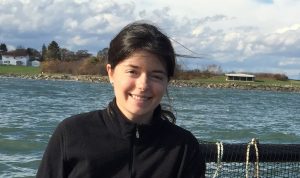Search results for: Saudi Arabian Airlines USA 1800-299-7264 Customer Service Phone Number
Focal Points – Shellfish Aquaculture in Massachusetts
Focal Points – Shellfish Aquaculture in Massachusetts September 2000 – Shellfish aquaculture in Massachusetts is thriving! Though centuries old, the practice of farming shellfish is a fairly recent undertaking in the United States—within the last 150 years.
Read MoreHolocene Sedimentation in the Shallow Nearshore Zone off Nauset Inlet, Cape Cod, Massachusetts
Holocene Sedimentation in the Shallow Nearshore Zone off Nauset Inlet, Cape Cod, Massachusetts Aubrey, D.G., D.C. Twichell, and S.L. Pfirman Marine Geology, Vol. 47, pp. 243-259, 1982 WHOI-R-82-007
Read MoreWHOI-R-87-003 Yossi Mart & David A. Ro
WHOI-R-87-003 Yossi Mart & David A. Ro
Read MoreKnauss Profile: Amalia Aruda Almada
Amalia Aruda Almada has long had an interest in the connection between ocean science and public health. As an undergraduate at Georgetown University, Almada had read about the oceanographer and microbiologist Rita Colwell, who was the first scientist to show that freshwater copepods—barely visible …
Read MoreRhythmic Beach Cusp Formation: A Conceptual Synthesis
Rhythmic Beach Cusp Formation: A Conceptual Synthesis Seymour, R.J. and D.G. Aubrey Marine Geology, Vol. 65, pp. 289-302, 1985 WHOI-R-85-017
Read MoreGrowth and Survival of Larvae of Mercenaria mercenaria (l.) and Crassostrea virginica (gmelin) Relative to Broodstock Conditioning and Lipid Content of Eggs
Growth and Survival of Larvae of Mercenaria mercenaria (l.) and Crassostrea virginica (gmelin) Relative to Broodstock Conditioning and Lipid Content of Eggs Gallager, S.M. and R. Mann Aquaculture, Vol. 56, pp. 105-121, 1986 WHOI-R-86-010
Read MoreWHOI-R-05-004 Bernhard, A. E. Loss of Divers
WHOI-R-05-004 Bernhard, A. E. Loss of Divers
Read MoreShellfish Resource Management in Massachusetts
Shellfish Resource Management in Massachusetts Helpful to educators and students. Leavitt, D.F. Focal Points, 3 pp., 2000 WHOI-G-00-003
Read MoreSea Grant Two if by Sea Vol. 9 No. 1 A joint n
Sea Grant Two if by Sea Vol. 9 No. 1 A joint n
Read MoreHurricanes
Hurricanes Though it has been 30 years since the last major hurricane struck the Massachusetts coast, hurricanes can be devastating and they can happen here! Be smart and prepare yourself, your family and your home to minimize losses from a hurricane. https://seagrant.whoi.edu/wp-content/uploads/2020/04/Hurricanes_in_New_England.mp4 Preparing for a Hurricane in New England *From Homeowner’s Handbook to Prepare for…
Read More
